Gluing Wood Veneer Sheets With Woodworker’s Glue
Wood Veneer Factory Outlet.com
Gluing wood veneers with woodworker’s glue is a simple process, but it can be a bit messy. The wood veneer sheets are glued down using pressure and clamps. Gluing wood veneers with woodworker’s glue is one of the best ways to glue down wood veneers.
“Woodworker’s glue” is a generic term that refers to 5 different types of glues that are used in woodworking. These are: PVA glue, (polyvinyl acetate), hide glue, epoxy, cyanoacrylate (super glue), and polyurethane glue.
This article will talk about PVA glue, as it is the most commonly used woodworker’s glue for gluing wood veneers.
PVA glue, such as Elmer’s Wood Glue or Titebond is available at any hardware store or home center. PVA glue is an inexpensive water base glue. It is safe and easy to work with, and the cleanup is with water. It is non flammable. There are no fumes and you can work in an enclosed area. Work in temperatures above 50 degrees F.
The substrate should be wood or a wood product, such as plywood, particle board, or MDF (medium density fiberboard). The substrate should be “raw” – no finish, oil, paint, stain or old glue on the surface. If necessary, strip or sand the substrate to expose the bare surface.
If the substrate has dents or imperfections, patch them with wood putty or Bondo. Bondo is a body filler for vehicles and it is available at automotive stores. There are other patching agents that will work just as well and these are available at your local home center. Sand the patched areas smooth.
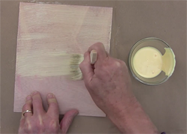 Use a paint brush to apply a light, even coat of the glue to the substrate and to the veneer. Don’t apply heavy coats of glue, as this will just cause excess glue to squeeze out from under the veneer when you glue it down.
Use a paint brush to apply a light, even coat of the glue to the substrate and to the veneer. Don’t apply heavy coats of glue, as this will just cause excess glue to squeeze out from under the veneer when you glue it down.
Position the veneer sheet in place on the substrate. The glue won’t set up for several minutes so will have plenty of time to position your veneer exactly where you want it. There is no need to be in a hurry.
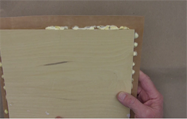 Most often, the glue will squeeze out at various points.
Most often, the glue will squeeze out at various points.
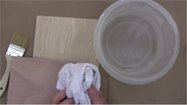 Squeeze out in some areas won't matter, but if you get squeeze out onto an important surface, it is imperative that you use a damp rag to remove all traces of glue immediately.
Squeeze out in some areas won't matter, but if you get squeeze out onto an important surface, it is imperative that you use a damp rag to remove all traces of glue immediately.
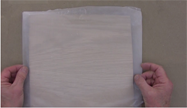 If you are veneering an inset panel, the veneer sheet should be cut to exact size ahead of time. For panels with outer edges that can be trimmed (cabinet door, for example), the veneer sheet can be about ½” larger on all sides. This makes it easy to position the veneer and you use a razor knife after the glue has dried to trim off the excess veneer from around the edges of the panel.
If you are veneering an inset panel, the veneer sheet should be cut to exact size ahead of time. For panels with outer edges that can be trimmed (cabinet door, for example), the veneer sheet can be about ½” larger on all sides. This makes it easy to position the veneer and you use a razor knife after the glue has dried to trim off the excess veneer from around the edges of the panel.
 When your veneer sheet is positioned in place on the substrate, put a flat board on top of it and apply pressure with clamps all over everywhere. Pressure is the key. You have to get good pressure all over the entire surface of the veneer so that the veneer is held tightly in place against the substrate while it dries.
When your veneer sheet is positioned in place on the substrate, put a flat board on top of it and apply pressure with clamps all over everywhere. Pressure is the key. You have to get good pressure all over the entire surface of the veneer so that the veneer is held tightly in place against the substrate while it dries.
It is a good idea to sandwich a sheet of waxed paper between the veneer sheet and the flat board. The waxed paper will prevent any glue that squeezes out from sticking to the flat board.
Leave the work piece clamped for 24 hours before removing the clamps.
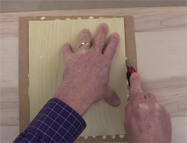 Use a razor knife to trim off the excess veneer around the edges.
Use a razor knife to trim off the excess veneer around the edges.
WARNING! Glue is the enemy of a finish. Let me state that again: Glue is the enemy of a finish. If glue squeezes out and gets on the surface of the veneer, you must take immediate steps to eliminate it. Use a damp rag to thoroughly remove any glue squeeze-out. If you don’t get the glue off of the surface of the veneer, it will wreak havoc with any finish that you apply later.
Likewise, be careful not to accidentally transfer glue from your fingers onto the surface of the veneer.
Bob Morgan, Pres.
![]()
Wood Veneer Factory Outlet.com
